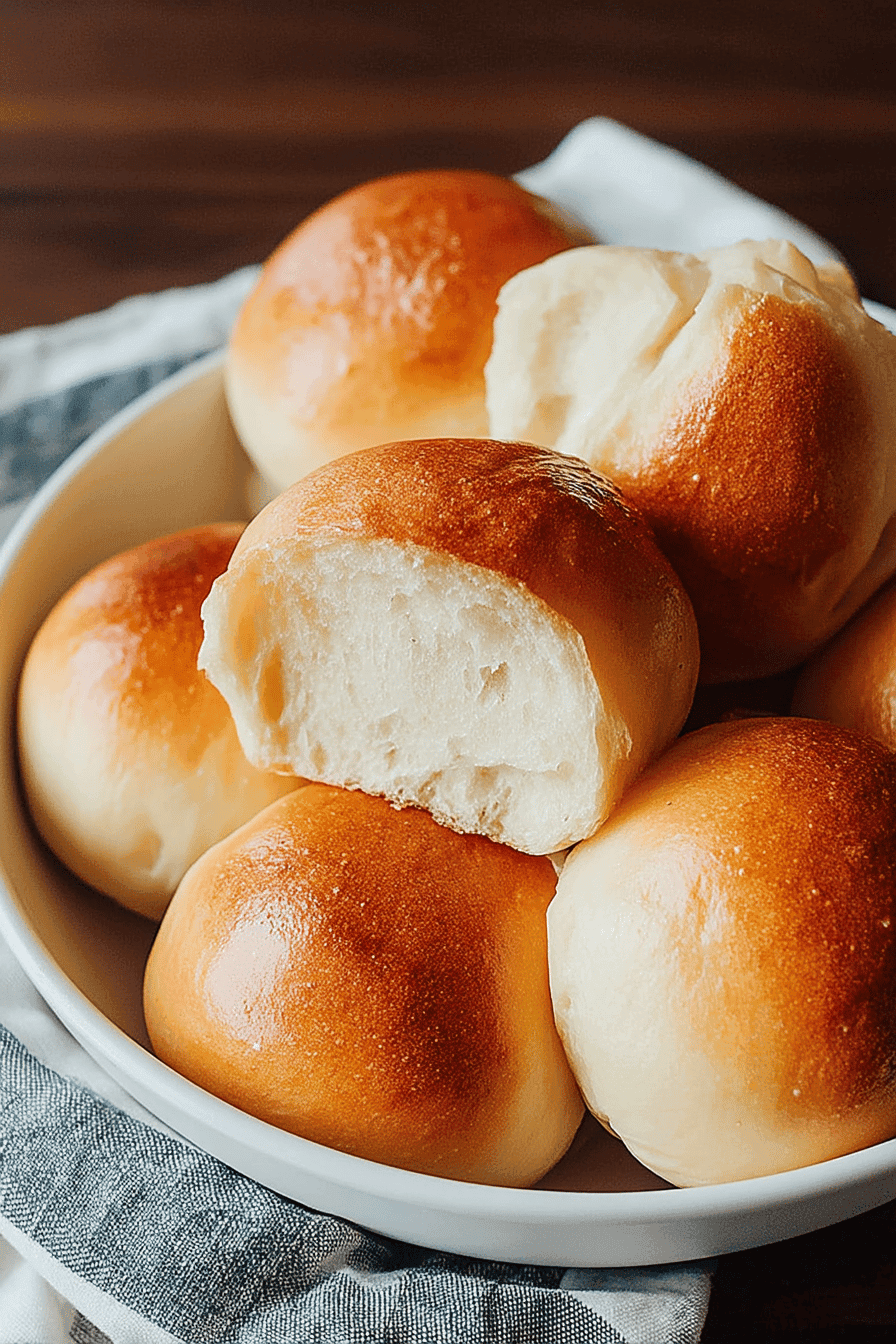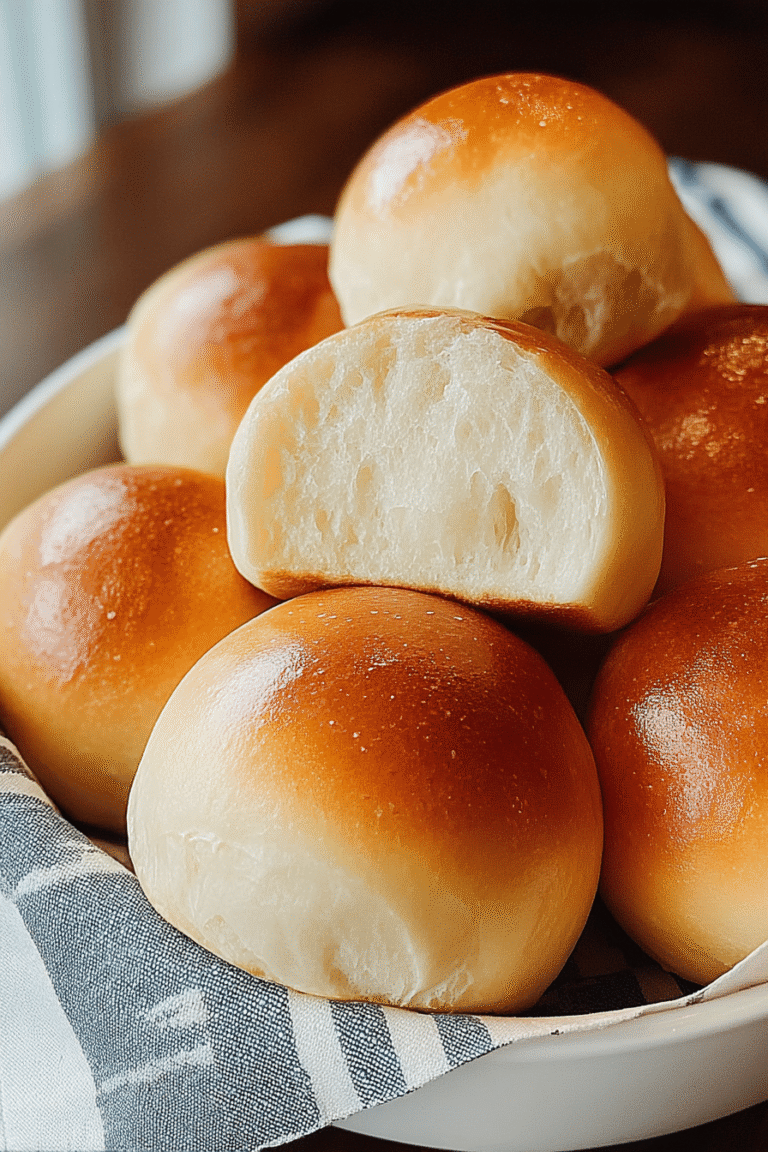Benefits and Advantages of sourdough dinner rolls
Sourdough dinner rolls offer a range of benefits that set them apart as a delightful choice for meals. Their natural fermentation process enhances flavor, producing a rich, tangy taste with a soft yet crusty texture that pleases the palate. This fermentation also improves digestibility by introducing natural probiotics, which support gut health and nutrient absorption, making sourdough easier on the stomach than conventional breads. Additionally, sourdough’s longer shelf life without preservatives appeals to those seeking artisanal, wholesome bread options. The recipe’s simplicity lets bakers of all levels create fluffy, tender rolls without intensive kneading, striking an ideal balance between traditional techniques and modern convenience. These sourdough dinner rolls provide a wholesome, flavorful alternative to common dinner bread, enriching any table setting with authentic artisan qualities.
Jump to:
- Benefits and Advantages of sourdough dinner rolls
- Essential Ingredients for sourdough dinner rolls
- Dietary Substitutions to Customize Your sourdough dinner rolls
- How to Prepare the Perfect sourdough dinner rolls: Step-by-Step Guide
- Mastering sourdough dinner rolls: Advanced Tips and Variations
- How to Store sourdough dinner rolls: Best Practices
- Nutritional Value of sourdough dinner rolls
- FAQs: Frequently Asked Questions About sourdough dinner rolls
- Can I double the sourdough dinner rolls recipe for a larger batch?
- How do I know when my sourdough dinner rolls dough has risen enough before baking?
- Can I use sourdough starter straight from the fridge to make these rolls?
- Why is my sourdough dinner roll dough too sticky or too dry, and how can I fix it?
- Can sourdough dinner rolls be baked as pull-apart rolls, and how should I do it?
- Simple No-Knead Crusty and Soft Sourdough Dinner Rolls Recipe
- Ingredients
- Instructions
- Last Step:
- Notes
- Nutrition
- Did you make this recipe?
Essential Ingredients for sourdough dinner rolls
- 1 cup (approx. 227 grams) active sourdough starter
- 3 ½ cups (about 420 grams) bread flour (can substitute all-purpose flour)
- 1 cup (240 ml) water (warm or room temperature, adjusted based on starter hydration)
- ½ teaspoon salt
- 3 tablespoons sugar (can reduce to 1 tablespoon or substitute with honey or coconut sugar)
- ¼ cup (60 ml) milk (dairy or non-dairy for vegan option)
- 3 tablespoons (about 42 grams) butter, melted (non-dairy butter for vegan option)
- 1 egg (optional, for egg wash to enhance crust color)
These ingredients work harmoniously: the sourdough starter drives fermentation, flour builds structure, water hydrates, salt enhances flavor, sugar feeds yeast and adds subtle sweetness, milk and butter enrich the crumb, and optionally egg wash adds a golden sheen. This combination delivers the perfect artisan sourdough dinner rolls that are soft, fluffy, and slightly sweet.

Dietary Substitutions to Customize Your sourdough dinner rolls
Customizing sourdough dinner rolls for different dietary needs is straightforward:
- Gluten-Free: Use a certified gluten-free sourdough starter and gluten-free flour blends, though expect a denser texture compared to traditional wheat rolls.
- Vegan: Substitute dairy milk with plant-based alternatives like oat or almond milk, and use non-dairy butter or coconut oil. Omit the egg or use plant-based egg substitutes for the wash.
- Low-Calorie: Reduce or omit the butter, use sugar substitutes like coconut sugar or honey sparingly, or replace sugar with natural sweeteners. Using water in place of milk can also lower calories.
- Flavor and Texture Variations: Add whole wheat or rye flour (up to half a cup) for extra fiber and flavor depth; adjust hydration slightly. For softness, ensure adequate fermentation and avoid over-kneading.
These thoughtful substitutions enable bakers to tailor sourdough dinner rolls while preserving their authentic qualities and comforting flavors.

How to Prepare the Perfect sourdough dinner rolls: Step-by-Step Guide
- Activate starter: Feed your sourdough starter 12 hours before mixing so it’s bubbly and active.
- Mix liquid ingredients: Melt butter and combine with milk, sugar, and salt; let cool to room temperature.
- Combine dough: In a bowl or mixer, blend the cooled liquid mixture with sourdough starter, flour, and water to form a slightly tacky dough.
- Rest and stretch: Cover and rest dough for 1 hour, then perform three sets of stretch and folds spaced 30 minutes apart.
- Bulk ferment: Let dough rise 2–3 hours until increased by about 50%, depending on room temperature.
- Shape rolls: Turn dough onto floured surface; divide into 12 portions (~65g each) and shape balls to build surface tension.
- Final rise: Place rolls close together in greased 9×13-inch dish, cover, and proof 3–4 hours until puffed and nearly doubled.
- Optional egg wash: Brush tops with beaten egg for golden crust.
- Bake: Preheat oven to 375°F (190°C) for glass dish or 400°F (204°C) for metal; bake 25–30 minutes until golden and reaching 190°F internal temperature.
- Finish: Brush warm rolls with melted butter for extra richness; cool slightly before serving.
This procedural guide balances traditional sourdough techniques with practical timing, allowing you to produce artisan-quality, soft, and crusty dinner rolls.
Mastering sourdough dinner rolls: Advanced Tips and Variations
To take your sourdough dinner rolls to the next level, consider these expert tips:
- Maintain consistent proofing temperatures around 75°F (24°C) to optimize fermentation and flavor development.
- Experiment with hydration levels: wetter doughs create lighter, airier rolls but require gentle handling.
- Add whole grain flours like whole wheat or rye (up to ½ cup) to boost flavor complexity and nutrition.
- Try mix-ins such as herbs (rosemary, thyme) or roasted garlic for unique, savory notes.
- Shape rolls into braids or knots for visually stunning presentations perfect for special occasions.
- Use retardation (refrigerate dough overnight) to intensify sour flavor and improve crumb structure.
- Practice scoring patterns for an artisanal look and controlled oven spring.
Attention to temperature, hydration, and proofing timings transforms simple sourdough dinner rolls into artisan masterpieces bursting with flavor and delicate texture.
These variations and techniques help balance tradition and creativity, producing consistent, impressive rolls that shine at any table.
How to Store sourdough dinner rolls: Best Practices
Proper storage is essential to maintain the freshness, texture, and flavor of your sourdough dinner rolls. For short-term storage, keep the rolls at room temperature in a paper bag or bread box, which helps preserve the crust’s crispness while preventing moisture buildup that can cause sogginess. This method is ideal for consumption within 1 to 2 days.
For longer storage, refrigerate the rolls in an airtight container or sealed plastic bag to extend their freshness up to a week; however, refrigeration may slightly dry out the crust. To maintain softness, you can reheat the rolls in a preheated oven at 350°F (175°C) for 5 to 10 minutes before serving.
For freezing, wrap each roll tightly with plastic wrap and then aluminum foil to protect against freezer burn. Frozen sourdough dinner rolls can be stored for up to three months. When ready to eat, thaw the rolls at room temperature and, if desired, warm them in a preheated oven at 350°F (175°C) for 5 to 10 minutes to refresh the texture and aroma.
Following these best practices goes a long way to keeping your sourdough dinner rolls tasting freshly baked and delightful for every meal.
Nutritional Value of sourdough dinner rolls
| Nutrient | Amount per Roll (approx.) |
|---|---|
| Calories | 160-230 kcal |
| Protein | about 5 g |
| Carbohydrates | 29-39 g |
| Fat | 3-6 g (varies with butter/milk used) |
| Fiber | Varies based on flour type used |
| Sodium | Depends on salt added, moderate amounts |
Sourdough dinner rolls offer a moderate calorie level mainly from carbohydrates, providing a good source of energy. The protein content supports muscle maintenance, while fats primarily come from added butter or milk, contributing richness and satiety. Their natural fermentation process lowers the glycemic index compared to conventional bread, potentially benefiting blood sugar control. Variations using whole grain flours increase fiber, aiding digestion and fullness. This nutritional balance makes sourdough dinner rolls a wholesome and satisfying addition to any meal.

FAQs: Frequently Asked Questions About sourdough dinner rolls
Can I double the sourdough dinner rolls recipe for a larger batch?
How do I know when my sourdough dinner rolls dough has risen enough before baking?
Can I use sourdough starter straight from the fridge to make these rolls?
Why is my sourdough dinner roll dough too sticky or too dry, and how can I fix it?
Can sourdough dinner rolls be baked as pull-apart rolls, and how should I do it?

Simple No-Knead Crusty and Soft Sourdough Dinner Rolls Recipe
🍞 Revel in the delightful combination of a soft, fluffy interior with a crispy crust, these sourdough rolls are perfect for any meal!
🌾 Enjoy the nuanced, tangy flavor developed through a simple no-knead process and natural fermentation, creating an authentic dining experience.
- Total Time: 8-9 hours
- Yield: 12 rolls 1x
Ingredients
1 cup (approx. 227 grams) active sourdough starter
3 ½ cups (about 420 grams) bread flour (can substitute all-purpose flour)
1 cup (240 ml) water (warm or room temperature)
½ teaspoon salt
3 tablespoons sugar (or honey or coconut sugar)
¼ cup (60 ml) milk (dairy or non-dairy)
3 tablespoons (about 42 grams) butter, melted (or non-dairy butter)
1 egg (optional, for egg wash)
Instructions
1. Feed the sourdough starter 12 hours before preparing the dough to ensure it’s active and bubbly.
2. Melt the butter and combine with milk, sugar, and salt; let cool.
3. In a large bowl, mix the cooled liquid with the sourdough starter, flour, and water until a slightly tacky dough forms.
4. Cover and rest the dough for 1 hour.
5. Perform three sets of stretch and folds every 30 minutes.
6. Let the dough rest for an additional 2 hours or until it has risen about 50%.
7. Turn the dough onto a floured surface and divide into 12 equal pieces, around 65 grams each.
8. Shape each into a smooth ball and place in a lightly greased baking dish.
9. Cover and let them rise for 3-4 hours until puffy and nearly doubled.
10. Preheat the oven to the necessary temperature (375°F for glass, 400°F for metal dishes).
11. Bake rolls for 25-30 minutes until golden brown.
12. Brush with melted butter after baking.
Last Step:
Please leave a rating and comment letting us know how you liked this recipe! This helps our business to thrive and continue providing free, high-quality recipes for you.Notes
⏲️ Rising times depend on kitchen temperature, adjust accordingly.
🧈 Dough can be refrigerated up to 3 days or frozen before the second rise.
🍞 Bread flour provides a better rise, but all-purpose works too.
- Prep Time: 15-20 minutes
- Resting and rising: 7-8 hours
- Cook Time: 25-30 minutes
- Category: Side Dish
- Method: Baking
- Cuisine: American
- Diet: Vegetarian
Nutrition
- Serving Size: 1 roll
- Calories: 160-230 kcal
- Fat: 3-6 g
- Carbohydrates: 29-39 g
- Protein: 5 g







